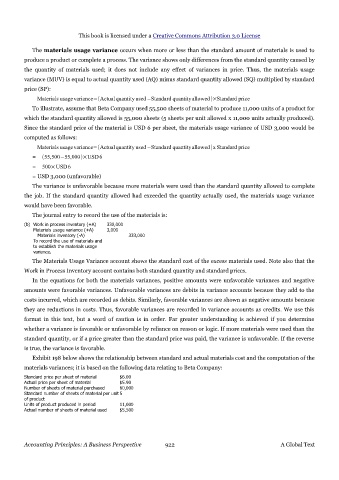Page 921 - Accounting Principles (A Business Perspective)
P. 921
This book is licensed under a Creative Commons Attribution 3.0 License
The materials usage variance occurs when more or less than the standard amount of materials is used to
produce a product or complete a process. The variance shows only differences from the standard quantity caused by
the quantity of materials used; it does not include any effect of variances in price. Thus, the materials usage
variance (MUV) is equal to actual quantity used (AQ) minus standard quantity allowed (SQ) multiplied by standard
price (SP):
Materials usagevariance=Actualquantity used –Standard quantityallowed ×Standard price
To illustrate, assume that Beta Company used 55,500 sheets of material to produce 11,000 units of a product for
which the standard quantity allowed is 55,000 sheets (5 sheets per unit allowed x 11,000 units actually produced).
Since the standard price of the material is USD 6 per sheet, the materials usage variance of USD 3,000 would be
computed as follows:
Materials usagevariance=Actualquantity used –Standard quantityallowed x Standard price
= 55,500−55,000×USD6
= 500×USD6
= USD 3,000 (unfavorable)
The variance is unfavorable because more materials were used than the standard quantity allowed to complete
the job. If the standard quantity allowed had exceeded the quantity actually used, the materials usage variance
would have been favorable.
The journal entry to record the use of the materials is:
(b) Work in process inventory (+A) 330,000
Materials usage variance (+A) 3,000
Materials inventory (-A) 333,000
To record the use of materials and
to establish the materials usage
variance.
The Materials Usage Variance account shows the standard cost of the excess materials used. Note also that the
Work in Process Inventory account contains both standard quantity and standard prices.
In the equations for both the materials variances, positive amounts were unfavorable variances and negative
amounts were favorable variances. Unfavorable variances are debits in variance accounts because they add to the
costs incurred, which are recorded as debits. Similarly, favorable variances are shown as negative amounts because
they are reductions in costs. Thus, favorable variances are recorded in variance accounts as credits. We use this
format in this text, but a word of caution is in order. Far greater understanding is achieved if you determine
whether a variance is favorable or unfavorable by reliance on reason or logic. If more materials were used than the
standard quantity, or if a price greater than the standard price was paid, the variance is unfavorable. If the reverse
is true, the variance is favorable.
Exhibit 198 below shows the relationship between standard and actual materials cost and the computation of the
materials variances; it is based on the following data relating to Beta Company:
Standard price per sheet of material $6.00
Actual price per sheet of material $5.90
Number of sheets of material purchased 60,000
Standard number of sheets of material per unit 5
of product
Units of product produced in period 11,000
Actual number of sheets of material used $5,500
Accounting Principles: A Business Perspective 922 A Global Text

